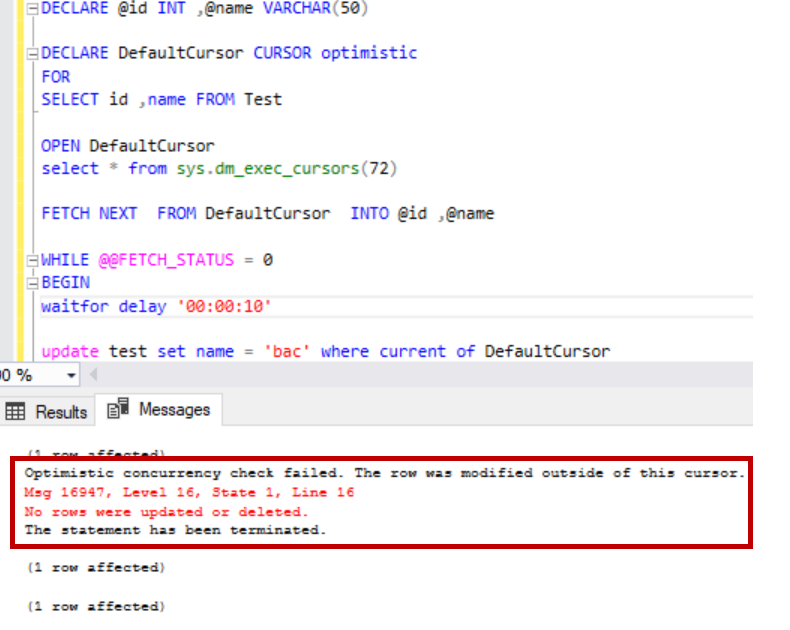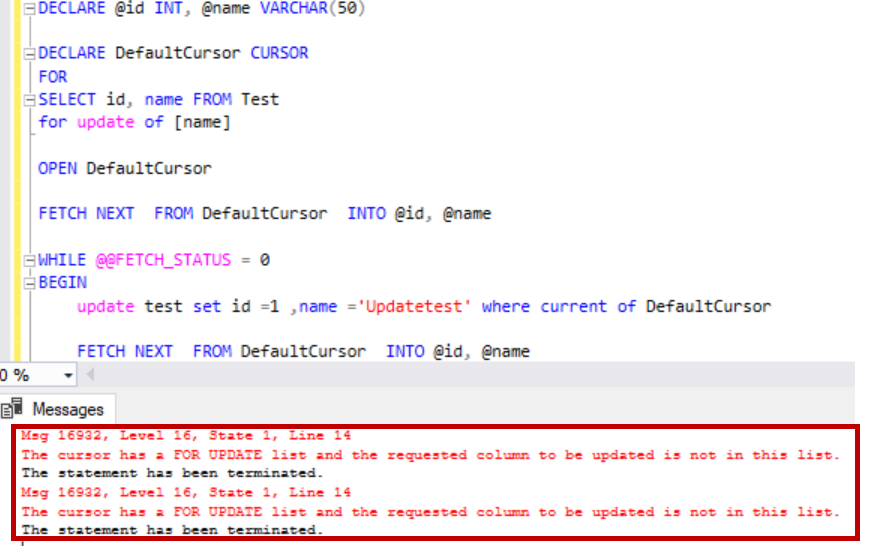A SQL Server cursor is a database object that is used to process the data in a set row by row. In this article, we will review how to create a cursor and different attributes used while declaring a cursor.
Creating cursor
Below are the steps involved in creating a cursor.
- Declare – Declares the cursor with a name and the select statement which populates the result set
- Open – Opens a cursor and populates the cursor by executing the select statement which is specified while declaring a cursor
- Fetch – To retrieve a specific row from the cursor based on the fetch arguments like NEXT, FIRST, LAST, etc
- Close – Closes the current result set of SQL Server cursor and can be reopened
- Deallocate – Removes cursor reference and releases all the resources associated with a cursor
Let us create a sample table, insert a few rows and perform cursor operations on the table with different attributes.
|
1 2 3 4 |
CREATE TABLE Test ( id INT, Name VARCHAR(50) ) INSERT INTO Test values (1,'John') INSERT INTO Test values (2,'Mike') |
The syntax for creating a cursor with default attributes.
|
1 2 3 4 5 6 7 8 9 10 11 12 13 14 15 16 17 18 19 20 |
DECLARE @id INT, @name VARCHAR(50) DECLARE DefaultCursor CURSOR FOR SELECT id, name FROM Test OPEN DefaultCursor FETCH NEXT FROM DefaultCursor INTO @id, @name WHILE @@FETCH_STATUS = 0 BEGIN SELECT @id, @name FETCH NEXT FROM DefaultCursor INTO @id, @name END CLOSE DefaultCursor DEALLOCATE DefaultCursor |
By default, the scope of the cursor is defined based on the Default cursor setting at the database level. To check or change the current setting, navigate to the database in SQL Server management studio, right click on the database and click on Properties. Click on Options. You can see the current setting is GLOBAL in this case. If you want to change the default scope of SQL Server cursor, then click on the drop down and change it to LOCAL and click on OK
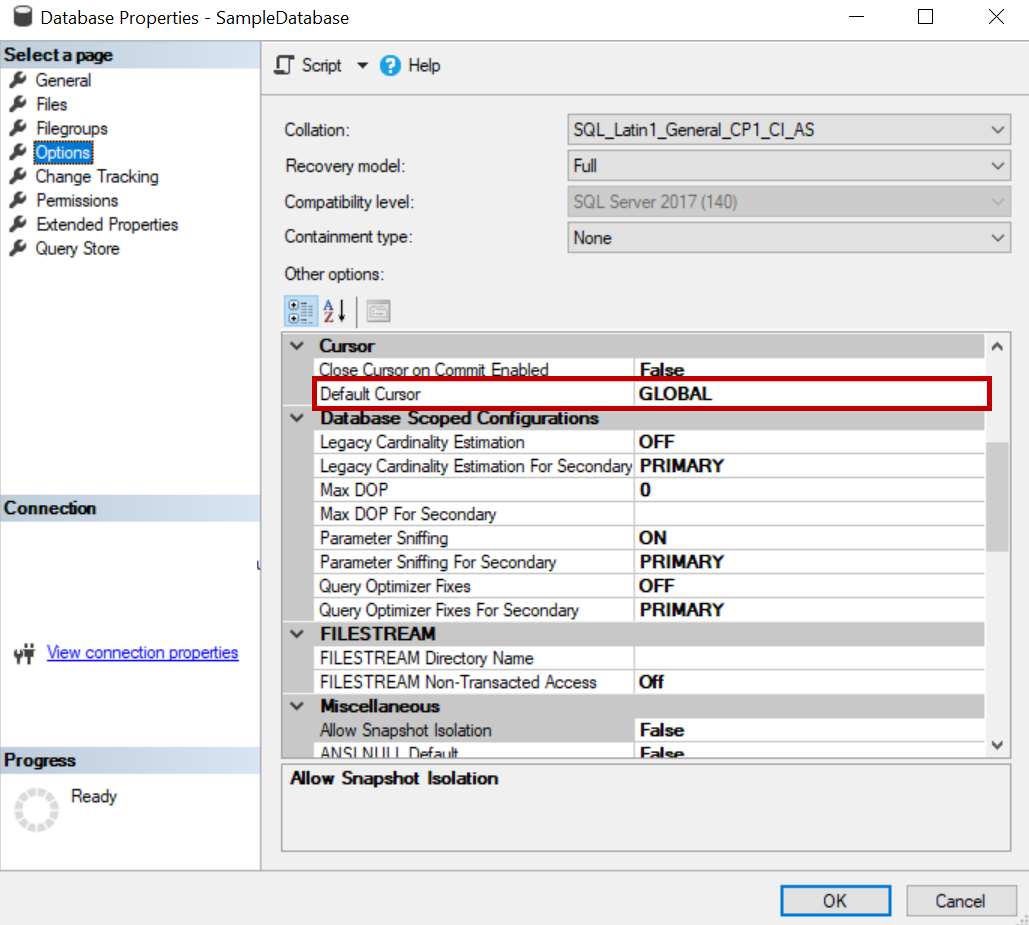
You can also change this setting using T-SQL. Execute the below statement to change the default setting to LOCAL.
|
1 2 3 4 |
USE [master] GO ALTER DATABASE [SampleDatabase] SET CURSOR_DEFAULT LOCAL WITH NO_WAIT GO |
Execute the below statement to change the default setting to GLOBAL. Replace database name with your database name.
|
1 2 3 4 |
USE [master] GO ALTER DATABASE [SampleDatabase] SET CURSOR_DEFAULT GLOBAL WITH NO_WAIT GO |
LOCAL
If the cursor is created with LOCAL attribute then the scope of the cursor is limited to that batch, stored procedure or trigger in which the cursor was created.
Let us try declaring a local cursor in one batch and open it in another batch.
|
1 2 3 |
DECLARE DefaultCursor CURSOR LOCAL FOR SELECT id, name FROM Test |
And when you try to open the SQL Server cursor in another batch it throws errors as the scope of the cursor is limited to a batch where it was created. Please refer to the below image for the error.
|
1 |
OPEN DefaultCursor |
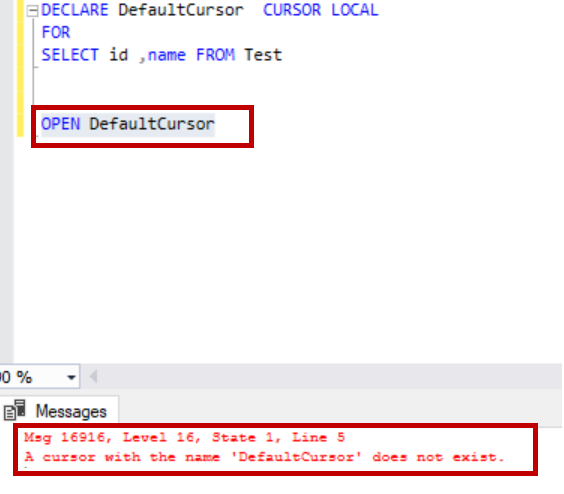
All the statements referencing the cursor name should go in one batch if the cursor is declared with local attribute.
|
1 2 3 4 5 6 7 8 9 10 11 12 13 14 15 16 17 18 19 20 21 |
DECLARE @id INT, @name VARCHAR(50) DECLARE DefaultCursor CURSOR LOCAL FOR SELECT id, name FROM Test OPEN DefaultCursor FETCH NEXT FROM DefaultCursor INTO @id, @name WHILE @@FETCH_STATUS = 0 BEGIN SELECT @id, @name FETCH NEXT FROM DefaultCursor INTO @id, @name END CLOSE DefaultCursor DEALLOCATE DefaultCursor |
Please refer to the below image when the cursor is declared as local and all the referencing statements are executed in one batch.
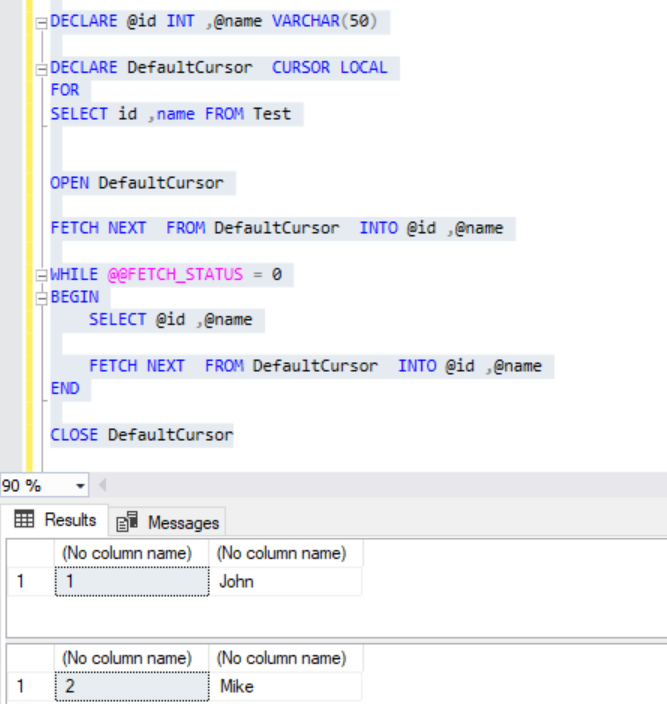
GLOBAL
If the cursor is created with GLOBAL attribute, the scope is cursor is not limited to the batch where it was created, and the cursor name can be referenced by any batch in the same connection.
Let us declare SQL Server cursor with a global attribute in one batch and try to use the cursor reference in another batch.
|
1 2 3 |
DECLARE DefaultCursor CURSOR GLOBAL FOR SELECT id, name FROM Test |
Now we will open cursor and fetch the current record in another batch.
|
1 2 |
OPEN DefaultCursor FETCH NEXT FROM DefaultCursor |
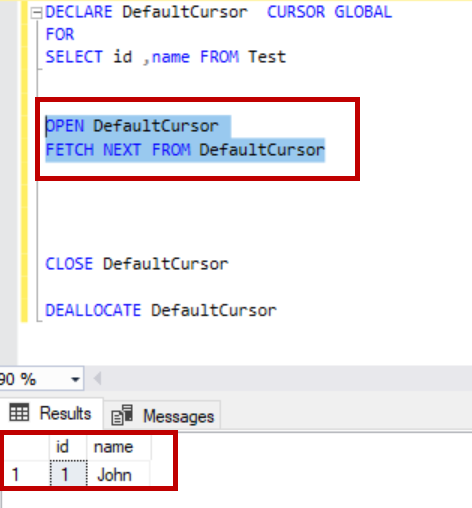
We must issue a DEALLOCATE command on the cursor to remove the cursor references or the cursor references will be removed only on closing the connection.
FORWARD_ONLY
When a cursor is specified with FORWARD_ONLY, it can be scrolled from first to the last row using fetch next. All other fetch options are not supported. All the data changes made by other users before fetching the row are visible.
Let us create a FORWARD_ONLY cursor and try to use other fetch options like ‘LAST’ and ‘PRIOR’. It throws an error as shown in the below image.
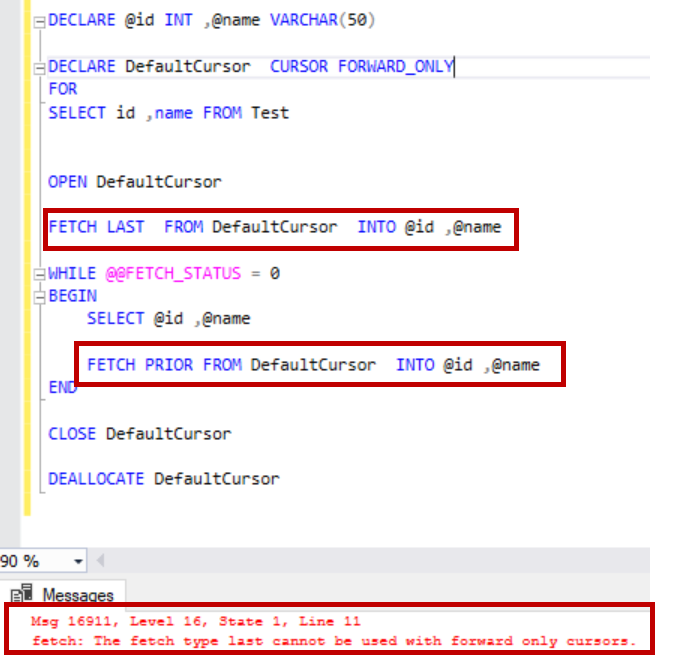
Only FETCH NEXT option is supported when the cursor is created with FORWARD_ONLY.
SCROLL
When a cursor is created with SCROLL attribute, all the fetch options are available. Below are different fetch options available.
- FIRST
- LAST
- PRIOR
- NEXT
- RELATIVE
- ABSOLUTE
Please refer to the below image for result set when a cursor is created with scroll and used LAST and PRIOR fetch options.
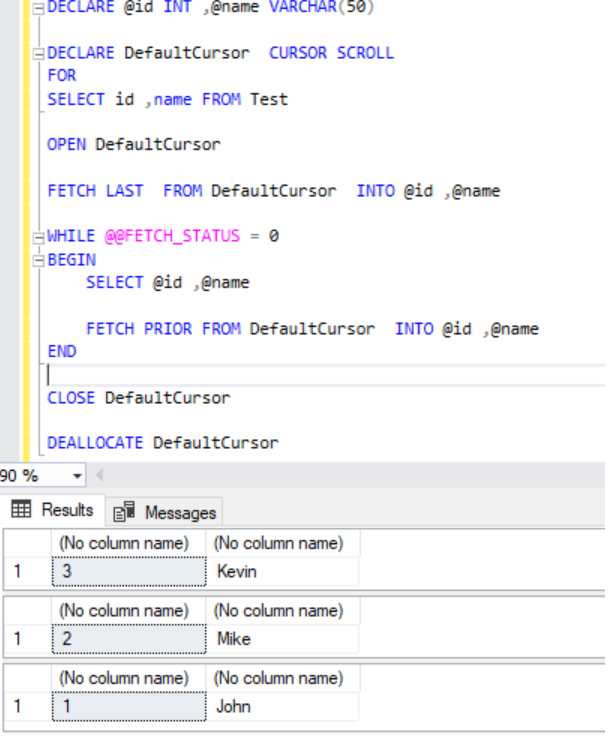
All the data changes made after opening the cursor are not visible. Create a cursor with a scroll and open it first.
|
1 2 3 4 5 6 |
DECLARE DefaultCursor CURSOR SCROLL FOR SELECT id, name FROM Test OPEN DefaultCursor |
Now open another session in SQL Server management studio and update the record where id=1
|
1 |
Update TEST set Name ='Lee' WHERE ID =1 |
Now go back to a session where the SQL Server cursor was created on executing below fetch statement. It still shows the old value.
|
1 |
FETCH NEXT FROM DefaultCursor |

SCROLL and FAST_FORWARD attributes cannot be specified together in a cursor.
STATIC
Static cursor when opened creates a copy of the data returned by the select statement specified in declare statement and any further data changes are not visible. We cannot update or delete data in using the CURRENT OF as it is read-only.
Create a cursor with STATIC and open it first.
|
1 2 3 4 5 6 |
DECLARE DefaultCursor CURSOR STATIC FOR SELECT id, name FROM Test OPEN DefaultCursor |
Now open another session in SQL Server management studio and update the record where id=1
|
1 |
Update TEST set Name ='Peter' WHERE ID =2 |
Now go back to a session where the cursor was created on executing below fetch statement two times. It still shows the old value.
|
1 |
FETCH NEXT FROM DefaultCursor |
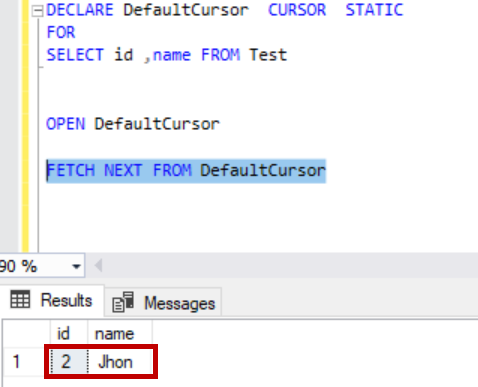
DYNAMIC
When a cursor is created with dynamic attribute all the changes made to rows inside cursor or outside cursor are visible when you fetch the new record. By default, if STATIC or FAST_FORWARD is not specified the cursor is created as dynamic.
To illustrate this, declare and opening the cursor.
|
1 2 3 4 5 |
DECLARE DefaultCursor CURSOR DYNAMIC FOR SELECT id, name FROM Test OPEN DefaultCursor |
In another session insert few more records or update them.
|
1 2 3 |
INSERT INTO Test values (3,'Palmer') Update Test set Name ='Kevin' where id =1 |
Now issue a fetch statement in the same session where you created a cursor.
|
1 2 3 4 5 6 |
FETCH NEXT FROM DefaultCursor while @@FETCH_STATUS =0 begin FETCH NEXT FROM DefaultCursor end |
We can see the data changes done outside of the cursor are reflected while fetching rows.
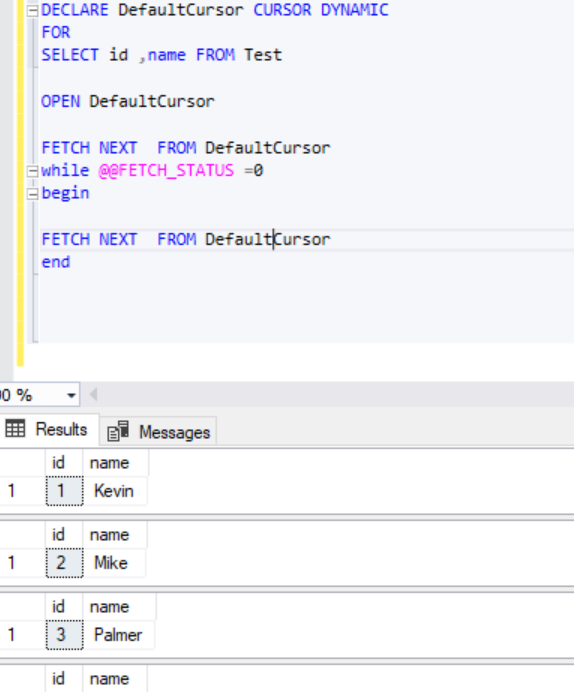
FAST_FORWARD
This enables READ_ONLY and FORWARD_ONLY on the cursor. This is the fastest SQL Server cursor and any changes to data are not visible once the cursor is opened. FAST_FORWARD cannot be specified along with SCROLL or FOR_UPDATE.
The syntax for creating a cursor with FAST_FORWARD
|
1 2 3 4 |
DECLARE DefaultCursor CURSOR FAST_FORWARD FOR SELECT id, name FROM Test order by ID |
READ_ONLY
This attribute on the cursor will not allow updates and deletes within the cursor using the CURRENT OF. Any data changes that occurred after opening cursor is not visible.
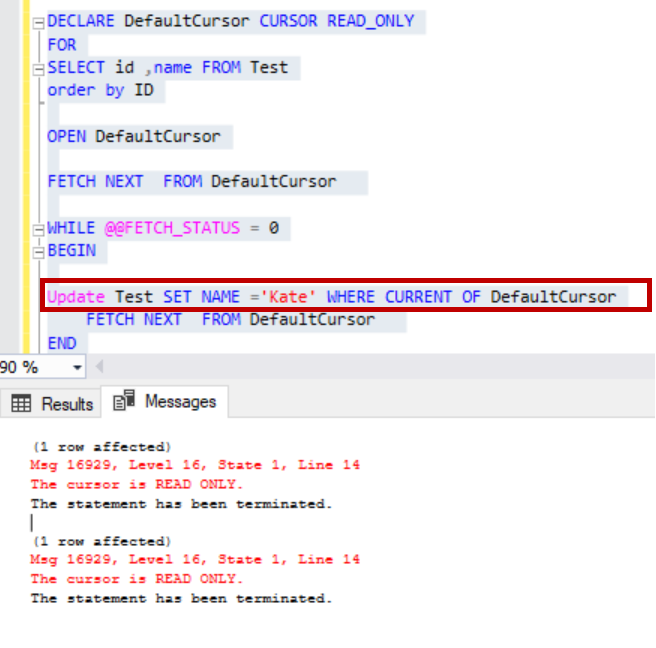
SCROLL_LOCKS
When the cursor is created with SCROLL_LOCKS attribute the rows which are fetched into cursor are locked.
Execute the below statements to create a cursor with SCROLL_LOCKS.
|
1 2 3 4 5 6 7 |
DECLARE DefaultCursor CURSOR SCROLL_LOCKS FOR SELECT id, name FROM Test OPEN DefaultCursor FETCH NEXT FROM DefaultCursor |
Now open another session in SQL Server management studio and try to update the data in the table. It will be blocked by the above SQL Server cursor.
|
1 |
UPDATE TEST SET NAME = 'LockTest' |
OPTIMISTIC
This attribute will not update or delete data inside the cursor by using the CURRENT OF when the data is modified by another user in a different session after fetch. It throws an error as shown in the below image.
It compares timestamp or checksum to see if the row was modified after fetch.
FOR UPDATE
This attribute specifies the updatable columns in the cursor. Only columns which are specified are updatable. If no column list was provided all columns of the table can be updated.
Sample cursor with no columns specified for an update. In this case, all columns in the table test can be updated inside the SQL Server cursor using the CURRENT OF.
|
1 2 3 4 5 6 7 8 9 10 11 12 13 14 15 16 17 18 19 20 21 |
DECLARE @id INT, @name VARCHAR(50) DECLARE DefaultCursor CURSOR FOR SELECT id, name FROM Test FOR UPDATE OPEN DefaultCursor FETCH NEXT FROM DefaultCursor INTO @id, @name WHILE @@FETCH_STATUS = 0 BEGIN UPDATE test set id =1 ,name ='Updatetest' where current of DefaultCursor FETCH NEXT FROM DefaultCursor INTO @id, @name END CLOSE DefaultCursor DEALLOCATE DefaultCursor |
Sample cursor with only one column specified in the update list. In this case, we cannot update the column “id”.
|
1 2 3 4 5 6 7 8 9 10 11 12 13 14 15 16 17 18 19 20 21 |
DECLARE @id INT, @name VARCHAR(50) DECLARE DefaultCursor CURSOR FOR SELECT id, name FROM Test FOR UPDATE of [name] OPEN DefaultCursor FETCH NEXT FROM DefaultCursor INTO @id, @name WHILE @@FETCH_STATUS = 0 BEGIN UPDATE test set id =1 ,name ='Updatetest' where current of DefaultCursor FETCH NEXT FROM DefaultCursor INTO @id, @name END CLOSE DefaultCursor DEALLOCATE DefaultCursor |
If we try to update the column which is not in the update of the list, then it throws an error as shown in below image.
To view properties of the cursor, use inline function sys.dm_exec_cursors. This returns the information of open cursors on all databases in the instance. This returns the information like on which session the cursor was opened, name of the cursor and properties. Please refer to below image for result set returned by the inline function.

I hope you have benefitted from this SQL Server cursor article. Feel free to provide feedback in the comments below.
- Geo Replication on Transparent Data Encryption (TDE) enabled Azure SQL databases - October 24, 2019
- Overview of the Collate SQL command - October 22, 2019
- Recover a lost SA password - September 20, 2019


